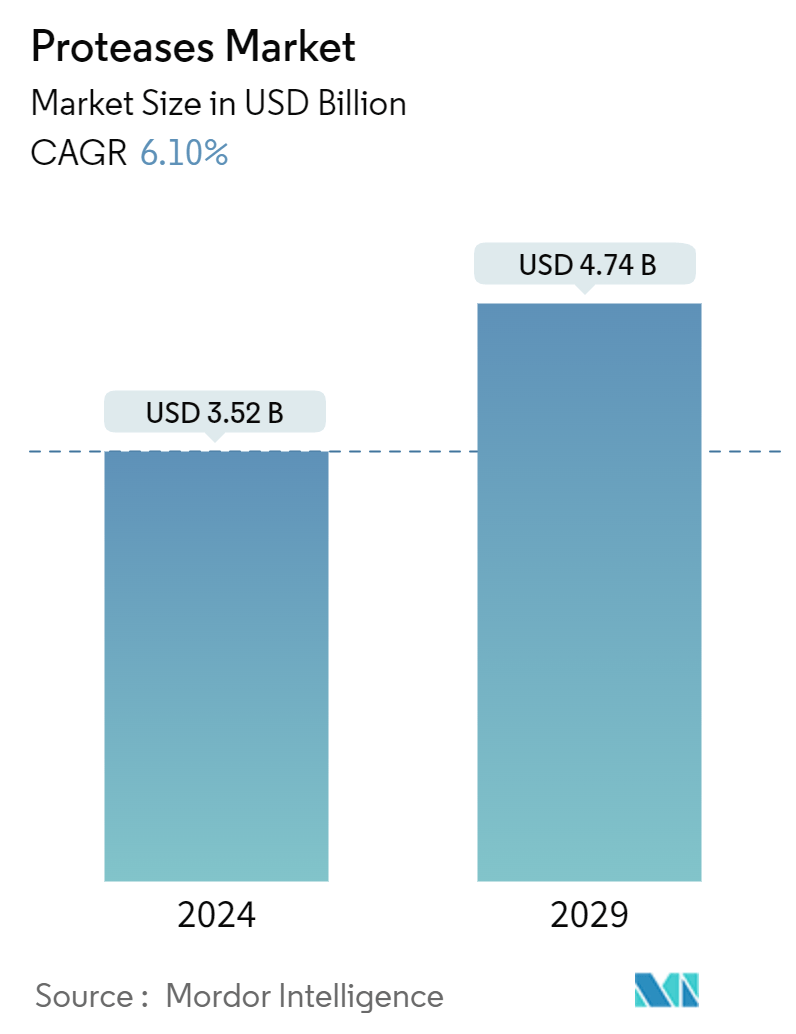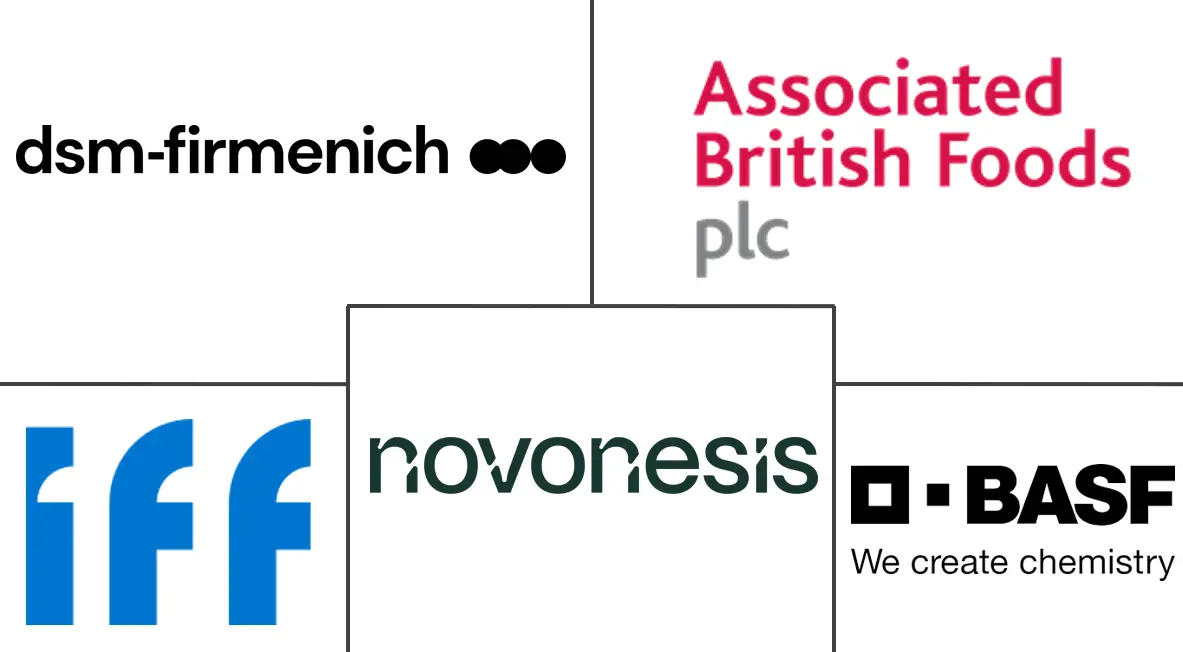Market Size of Proteases Industry

| Study Period | 2019 - 2029 |
| Market Size (2024) | USD 3.52 Billion |
| Market Size (2029) | USD 4.74 Billion |
| CAGR (2024 - 2029) | 6.10 % |
| Fastest Growing Market | Middle East and Africa |
| Largest Market | North America |
| Market Concentration | High |
Major Players
*Disclaimer: Major Players sorted in no particular order |
Proteases Market Analysis
The Proteases Market size is estimated at USD 3.52 billion in 2024, and is expected to reach USD 4.74 billion by 2029, growing at a CAGR of 6.10% during the forecast period (2024-2029).
The global processed food industry is experiencing significant growth, driven by changing consumer lifestyles that demand ready-to-cook/eat products. This is expected to drive the demand for proteases during the forecast period. Additionally, microbial proteases have gained interest due to their vital role in metabolic activities and their immense utilization in industries. The proteases available in the market that are of microbial origin offer higher yield, lower time consumption, and cost-effectiveness, which have made them suitable for biotechnological applications in the market.
Proteases are a diverse group of enzymes that act as proteinases, peptidases, and amidases and have a broad range of industrial applications, particularly in the food, detergent, and pharmaceutical industries. Proteases are essential industrial enzymes that break down peptide bonds in proteins and find numerous uses in chemical and biological processes. One of the main advantages of using proteases is their ability to produce natural products, exhibit activity under mild reaction conditions, and exhibit stereospecificity, specificity, and biodegradability. Companies have introduced innovative products that reduce reaction time to enhance overall yield. Proteases are crucial in developing many fast-moving consumer good (FMCG) products. The market's primary driver is the multiple applications of proteases in various industries. Additionally, their non-toxic and non-pathogenic attributes make them eco-friendly, further boosting the market.
Proteases are used in the animal feed industry to improve the nutritional content and digestibility of feed, which promotes better animal growth and general health. Proteases facilitate the easier absorption of complex proteins in the digestive tracts of animals like pigs, poultry, and aquaculture species by breaking them down into simpler peptides and amino acids. In addition to improving the effectiveness of nutrient utilization, this enzymatic action also lessens the anti-nutritional elements that may impede absorption and digestion. Furthermore, by reducing the need for high-protein feed ingredients, proteases can reduce feed costs and the environmental impact of animal production by reducing nitrogen excretion. According to the Bundesanstalt für Landwirtschaft und Ernährung, approximately 1.53 million tons of dressed-weight poultry were produced across Germany in 2023. The expansion of the animal husbandry industry and rising demand for animal feed offer ample opportunities for the protease market worldwide.
Proteases Industry Segmentation
Protease is an enzyme that catalyzes the hydrolysis of peptide bonds present in proteins and has many functions, including industrial and medical purposes, like extracting gums, processing food, and treating inflammation. The protease market is segmented by source, application, and geography. By source, the market is segmented into animal (which is further segmented into trypsin, pepsin, renin, and other animal sources), plant (which is further segmented into papain, bromelain, and other plant sources), and microbial, which is further segmented into alkaline protease, acid protease, and neutral protease. By application, the market is segmented into food and beverage (which is further segmented into dairy, bakery, beverages, meat and poultry, and infant formula), pharmaceuticals, animal feed, and other applications. By geography, the market is segmented into North America, Europe, Asia-Pacific, South America, and Middle East and Africa. The market sizing has been done in value terms (USD) for all the abovementioned segments.
| Source | ||||||
| ||||||
| ||||||
|
| Application | |||||||
| |||||||
| Pharmaceuticals | |||||||
| Animal Feed | |||||||
| Other Applications |
| Geography | ||||||||
| ||||||||
| ||||||||
| ||||||||
| ||||||||
|
Proteases Market Size Summary
The protease market is poised for significant growth, driven by its extensive applications across various industries, including food, detergents, and pharmaceuticals. Proteases, a crucial class of industrial enzymes, play a vital role in breaking down peptide bonds in proteins, making them indispensable in processes that require natural product production under mild conditions. Their non-toxic and eco-friendly nature further enhances their appeal, as they contribute to sustainable industrial practices by reducing waste and preserving natural resources. The food industry, in particular, benefits from proteases in meat tenderization, baked goods, and beverage production, with the global demand for processed foods fueling their adoption. The Asia-Pacific region, with its rapidly expanding processed food industry, presents a lucrative market for protease enzymes, driven by changing consumer lifestyles and increasing demand for high-quality, ready-to-eat products.
The protease market is characterized by a consolidated landscape, with major players like International Flavors & Fragrances, Inc., Koninklijke DSM NV, Novozymes AS, BASF SA, and Associated British Foods plc dominating the scene. These companies leverage strategies such as mergers, acquisitions, and product innovations to maintain their market positions and expand their portfolios. The introduction of new protease products, like DSM's ProAct 360‚Ñ¢ and Novozymes' Formea Prime, highlights the industry's focus on sustainable and innovative solutions. As the market continues to evolve, these key players are expected to drive further growth by catering to the increasing demand for protease enzymes across diverse applications, particularly in the burgeoning Asia-Pacific region.
Proteases Market Size - Table of Contents
-
1. MARKET DYNAMICS
-
1.1 Market Drivers
-
1.1.1 Technological Advancements in Enzyme Engineering & Bioprocessing
-
1.1.2 Growing Inclination Toward Specialty and Sustainable Ingredients
-
-
1.2 Market Restraints
-
1.2.1 High Production Costs Impede Market Growth
-
-
1.3 Porter's Five Forces Analysis
-
1.3.1 Threat of New Entrants
-
1.3.2 Bargaining Power of Buyers/Consumers
-
1.3.3 Bargaining Power of Suppliers
-
1.3.4 Threat of Substitute Products
-
1.3.5 Intensity of Competitive Rivalry
-
-
-
2. MARKET SEGMENTATION
-
2.1 Source
-
2.1.1 Animal
-
2.1.1.1 Trypsin
-
2.1.1.2 Pepsin
-
2.1.1.3 Renin
-
2.1.1.4 Other Animal Sources
-
-
2.1.2 Plant
-
2.1.2.1 Papain
-
2.1.2.2 Bromelain
-
2.1.2.3 Other Plant Sources (Keratinases and Ficin)
-
-
2.1.3 Microbial
-
2.1.3.1 Alkaline Protease
-
2.1.3.2 Acid Protease
-
2.1.3.3 Neutral Protease
-
-
-
2.2 Application
-
2.2.1 Food and Beverage
-
2.2.1.1 Dairy
-
2.2.1.2 Bakery
-
2.2.1.3 Beverages
-
2.2.1.4 Meat and Poultry
-
2.2.1.5 Infant Formula
-
-
2.2.2 Pharmaceuticals
-
2.2.3 Animal Feed
-
2.2.4 Other Applications
-
-
2.3 Geography
-
2.3.1 North America
-
2.3.1.1 United States
-
2.3.1.2 Canada
-
2.3.1.3 Mexico
-
2.3.1.4 Rest of North America
-
-
2.3.2 Europe
-
2.3.2.1 Spain
-
2.3.2.2 United Kingdom
-
2.3.2.3 France
-
2.3.2.4 Germany
-
2.3.2.5 Italy
-
2.3.2.6 Rest of Europe
-
-
2.3.3 Asia-Pacific
-
2.3.3.1 China
-
2.3.3.2 Japan
-
2.3.3.3 India
-
2.3.3.4 Singapore
-
2.3.3.5 Australia
-
2.3.3.6 Rest of Asia-Pacific
-
-
2.3.4 South America
-
2.3.4.1 Brazil
-
2.3.4.2 Argentina
-
2.3.4.3 Rest of South America
-
-
2.3.5 Middle East and Africa
-
2.3.5.1 South Africa
-
2.3.5.2 United Arab Emirates
-
2.3.5.3 Saudi Arabia
-
2.3.5.4 Rest of Middle East and Africa
-
-
-
Proteases Market Size FAQs
How big is the Proteases Market?
The Proteases Market size is expected to reach USD 3.52 billion in 2024 and grow at a CAGR of 6.10% to reach USD 4.74 billion by 2029.
What is the current Proteases Market size?
In 2024, the Proteases Market size is expected to reach USD 3.52 billion.

